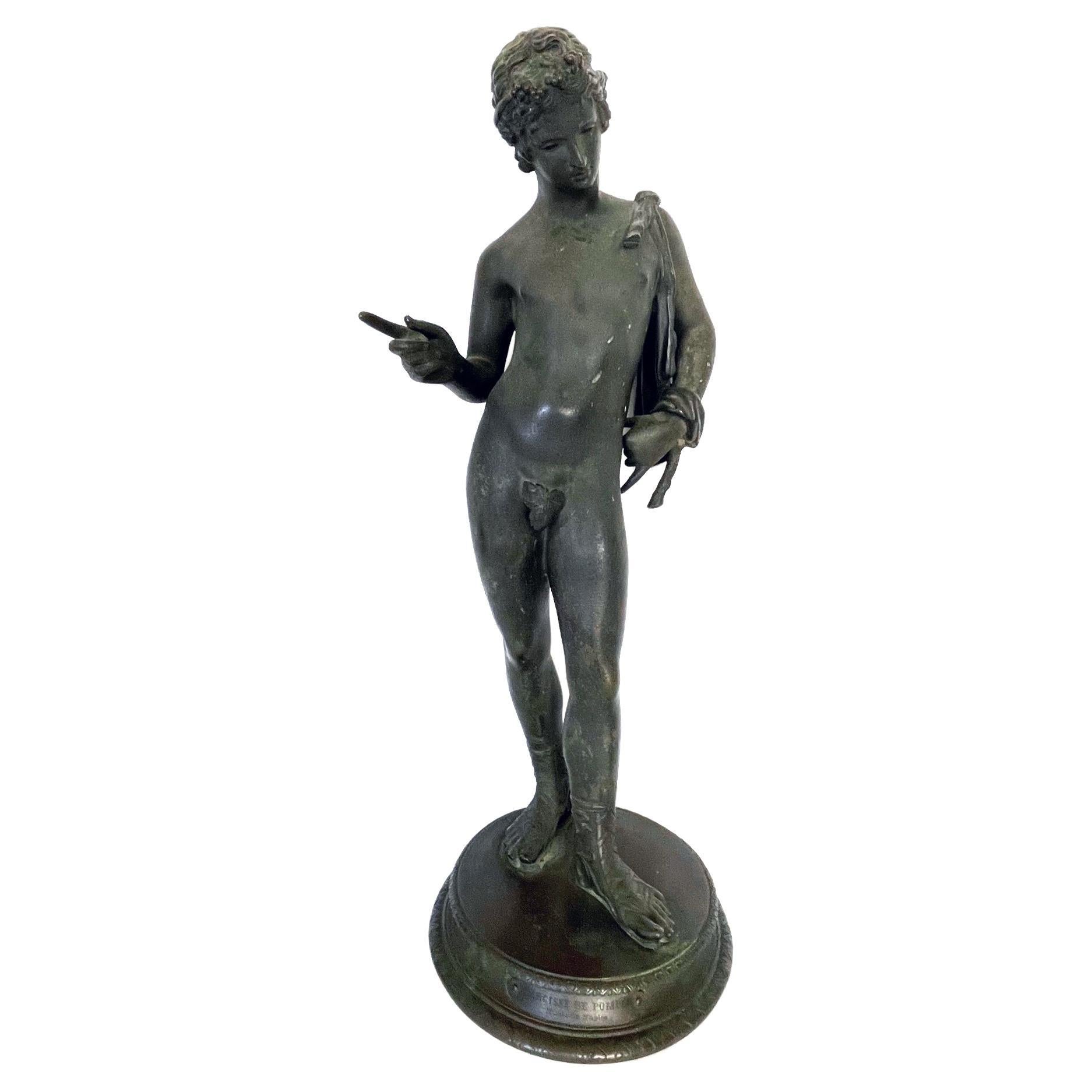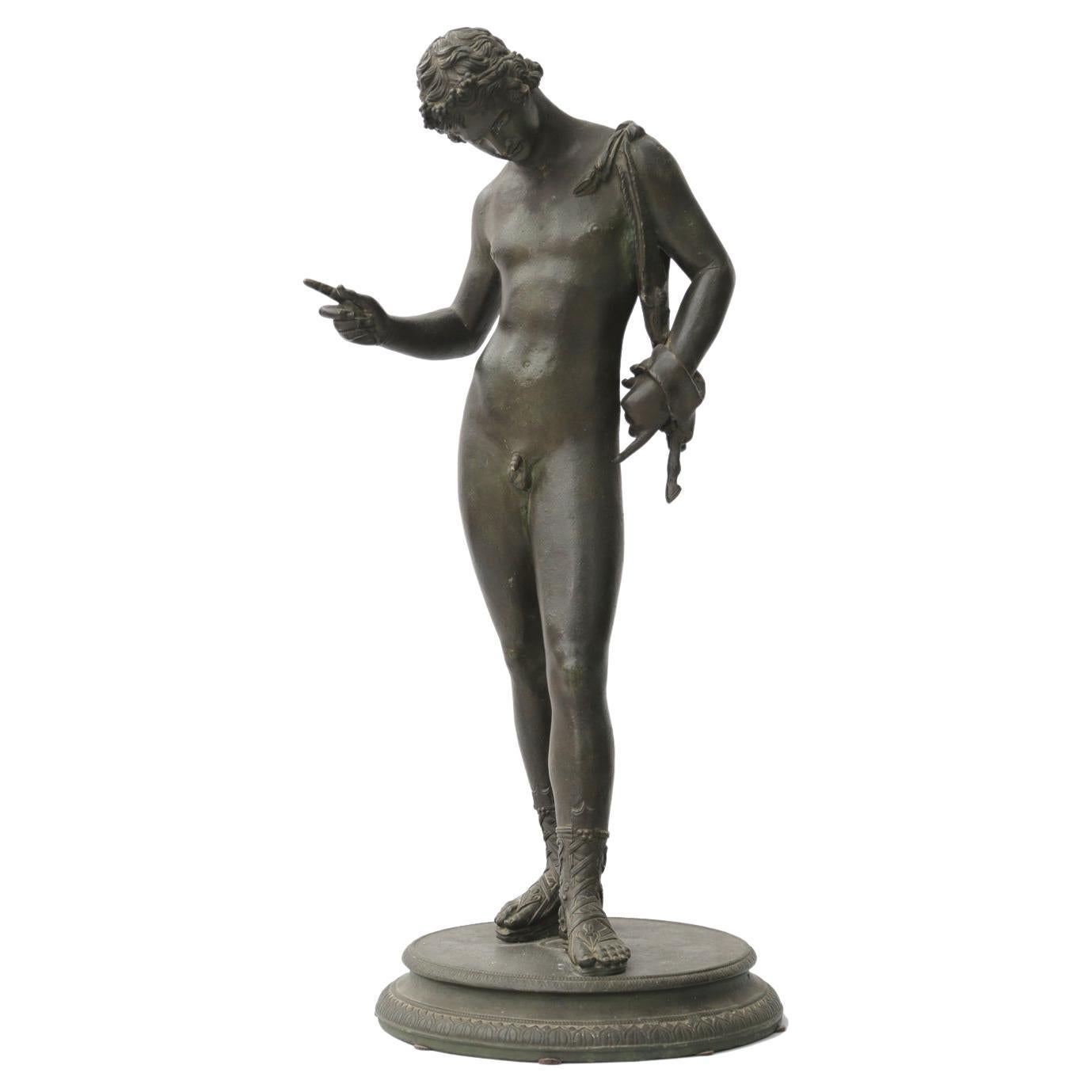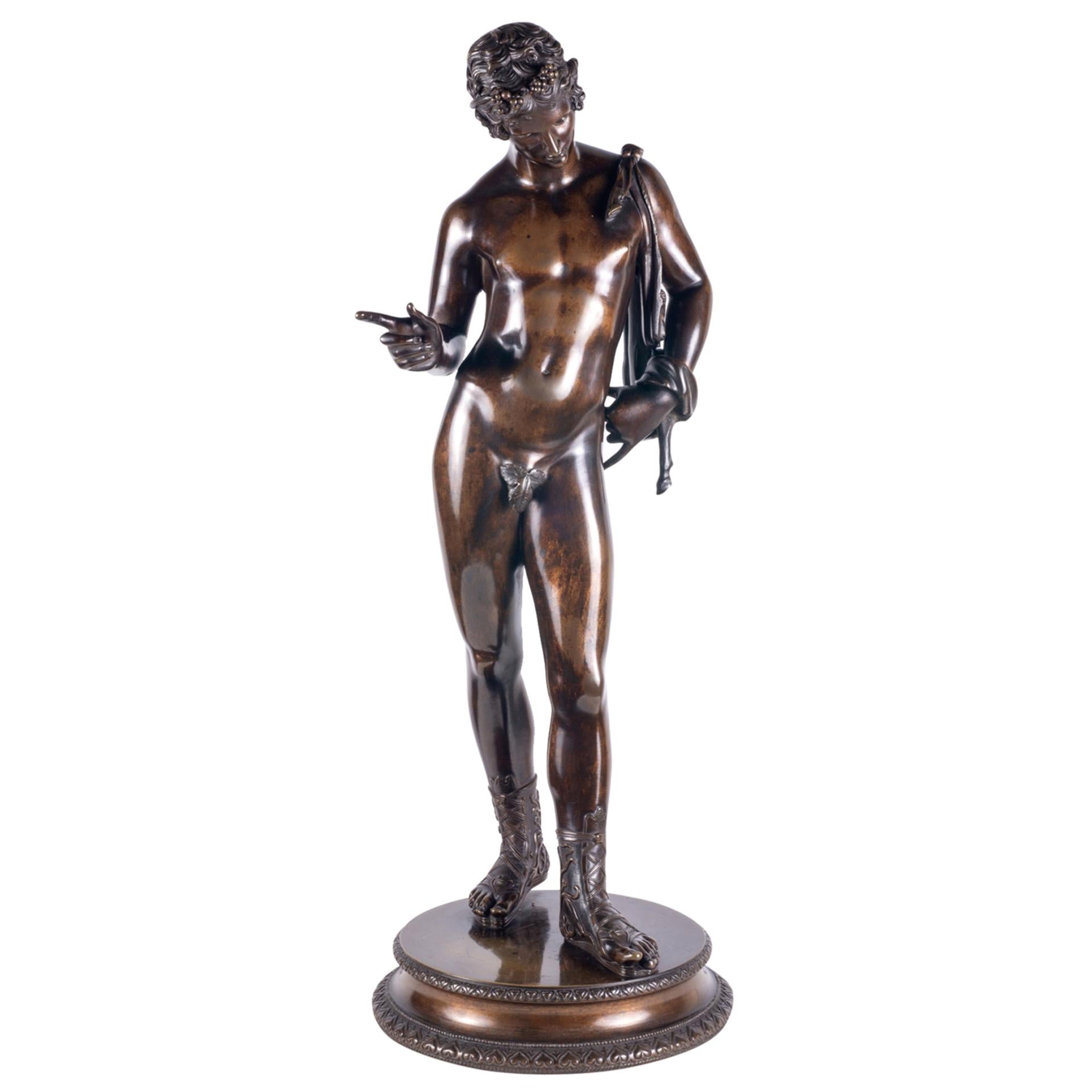Items Similar to Antique Grand Tour Patinated Bronze Figure of Narcissus 1870, 19th Century
Video Loading
Want more images or videos?
Request additional images or videos from the seller
1 of 11
Antique Grand Tour Patinated Bronze Figure of Narcissus 1870, 19th Century
About the Item
This is a superb antique Grand Tour patinated bronze figure of Narcissus, dating from the last quarter of the 19th Century.
Narcissus was a hunter in Greek mythology and he was distinguished for his beauty.
This stunning patinated bronze classical figure is after the original antique bronze which was found in Pompeii in 1862. It features Narcissus standing tall with his head slightly looking downward and is mounted on a marble turned plinth base.
This high-quality hot cast solid bronze was produced by using the traditional "lost wax" process, otherwise known as the "cire perdue" method.
The craftsmanship is second to none throughout all aspects of this bronze which is sure to add an unparalleled touch of class to your home.
Condition:
In excellent condition, please see photos for confirmation.
Dimensions in cm:
Height 53 x width 18 x depth 18
Dimensions in inches:
Height 20.9 x width 7.1 x depth 7.1
Narcissus was a hunter in Greek mythology, son of the river god Cephissus and the nymph Liriope. He was a very beautiful young man, and many fell in love with him. However, he only showed them disdain and contempt. One day, while he was hunting in the woods, the Oread nymph Echo spotted him and immediately fell for him. When Narcissus sensed that someone was following him, Echo eventually revealed herself and tried to hug him. However, he pushed her off and told her not to disturb him. Echo, in despair, roamed around the woods for the rest of her life, and wilted away until all it remained of her was an echo sound.
Nemesis, the goddess of retribution and revenge, learned what had happened and decided to punish Narcissus for his behaviour. She led him to a pool; there, the man saw his reflection in the water and fell in love with it. Although he did not realise in the beginning that it was just a reflection, when he understood it, he fell in despair that his love could not materialise and committed suicide.
The Grand Tour was the traditional trip of Europe undertaken by mainly upper-class European young men of means. The custom flourished from about 1660 until the advent of large-scale rail transit in the 1840s, and was associated with a standard itinerary.
It served as an educational rite of passage. Though primarily associated with the British nobility and wealthy landed gentry, similar trips were made by wealthy young men of Protestant Northern European nations on the Continent, and from the second half of the 18th century some South American, U.S., and other overseas youth joined in. The tradition was extended to include more of the middle class after rail and steamship travel made the journey less of a burden.
The primary value of the Grand Tour, it was believed, lay in the exposure both to the cultural legacy of classical antiquity and the Renaissance, and to the aristocratic and fashionably polite society of the European continent. In addition, it provided the only opportunity to view specific works of art, and possibly the only chance to hear certain music. A grand tour could last from several months to several years. It was commonly undertaken in the company of a knowledgeable guide or tutor.
The Grand Tour not only provided a liberal education but allowed those who could afford it the opportunity to buy things otherwise unavailable at home, and it thus increased participants' prestige and standing. Grand Tourists would return with crates of art, books, pictures, sculpture, and items of culture, which would be displayed in libraries, cabinets, gardens, and drawing rooms, as well as the galleries built purposely for their display; The Grand Tour became a symbol of wealth and freedom.
Lost Wax Method
sometimes called by the French name of cire perdue or the Latin, cera perduta is the process by which a bronze or brass is cast from an artists sculpture.
In industrial uses, the modern process is called investment casting. An ancient practice, the process today varies from foundry to foundry, but the steps which are usually used in casting small bronze sculptures in a modern bronze foundry are generally quite standardised.
- Dimensions:Height: 20.87 in (53 cm)Width: 7.09 in (18 cm)Depth: 7.09 in (18 cm)
- Materials and Techniques:Bronze,Patinated
- Period:
- Date of Manufacture:1870
- Condition:
- Seller Location:London, GB
- Reference Number:
About the Seller
5.0
Platinum Seller
These expertly vetted sellers are 1stDibs' most experienced sellers and are rated highest by our customers.
Established in 1983
1stDibs seller since 2012
1,195 sales on 1stDibs
Typical response time: 1 hour
Associations
LAPADA - The Association of Arts & Antiques Dealers
- ShippingRetrieving quote...Ships From: London, United Kingdom
- Return PolicyA return for this item may be initiated within 14 days of delivery.
More From This SellerView All
- Antique Grand Tour Patinated Bronze Figure of of David 19th CLocated in London, GBThis is a superb large antique Grand Tour patinated bronze version of David, dating from the mid 19th Century. The bronze statue depicts David with an enigmatic smile posed with ...Category
Antique 1850s Figurative Sculptures
MaterialsBronze
- Antique Italian Grand Tour Patinated Bronze Sculpture of St Peter, 19th CenturyLocated in London, GBA superb antique Italian Grand Tour patinated bronze sculpture of St Peter seated on a bronze throne, circa 1880 in date. This patinated bronze sculpture of St. Peter is after the original by Arnolfo di Cambio (1245-1302) in St. Peters basilica in Rome. It features St. Peter seated upon a carved marble throne...Category
Antique 1880s Italian Figurative Sculptures
MaterialsBronze
- Antique Monumental Grand Tour Bronze of Michelangelo David, 19th CenturyLocated in London, GBThis is an elegant monumental Grand Tour bronze sculpture of Michelangelo's David, circa 1880 in date. The full-length portrait statue is of David, the 14ft marble statue depicts the Biblical hero David, represented as a standing male nude, David looks tense and ready for battle after he has made the decision to fight Goliath, but, before the battle has actually taken place. His brow is drawn, his neck tense, and the veins bulge out of his lowered right hand and holding his slingshot over his shoulder. This impressive scuplture is 107cm (3ft 6" ) tall and weighs over 36kgs (79lbs). This high quality hot cast solid bronze was produced using the traditional 'lost wax' process. The attention to detail of this sculpture is absolutely fantastic. Condition: In really excellent condition, please see photos for confirmation. Dimensions in cm: Height 107 x Width 41 x Depth 24.5 Weight 36.3 kg Dimensions in inches: Height 3 foot, 6 inches x Width 1 foot, 4 inches x Depth 10 inches Weight 80.0 lbs Michelangelo's David This astonishing Renaissance sculpture was created between 1501 and 1504. It is a 14ft marble statue depicting the Biblical hero David, represented as a standing male nude. Originally commissioned by the Opera del Duomo for the Cathedral of Florence, it was meant to be one of a series of large statues to be positioned in the niches of the cathedral’s tribunes, way up at about 80mt from the ground. Michelangelo was asked by the consuls of the Board to complete an unfinished project begun in 1464 by Agostino di Duccio and later carried on by Antonio Rossellino in 1475. Both sculptors had in the end rejected an enormous block of marble due to the presence of too many “taroli”, or imperfections, which may have threatened the stability of such a huge statue...Category
Antique 1880s Figurative Sculptures
MaterialsBronze
- Antique Pair of French Grand Tour Bronze Marly Horses Sculptures 19th CenturyLocated in London, GBThis is a beautiful antique Grand Tour pair of French patinated-bronze sculptures of Marly Horses, Circa 1880 in date. The Marly Horses were commissioned by Louis XV of France scul...Category
Antique 1880s Figurative Sculptures
MaterialsBronze
- Antique Grand Tour Bronze Sculpture of Goddess Diana by Mercié 19th CenturyLocated in London, GBAn elegant French Grand Tour bronze figure of the Greek Goddess Diana by Marius-Jean-Antonin Mercié, French 1845 - 1916, dating from Circa 1880. The seated and robed Goddess Diana is holding a bow and arrows with her head downcast and raised on a circular plinth. Diana was originally considered to be a goddess of the wilderness and of the hunt, a central sport in both Roman and Greek culture. Early Roman inscriptions to Diana celebrated her primarily as a huntress and patron of hunters. Add a beautiful classical element to your home with this delightful bronze. Condition: In excellent condition with no dings, dents or signs of repair. Please see photos for confirmation. Dimensions in cm: Height 41 x Width 29 x Depth 19 Dimensions in inches: Height 1 foot, 4 inches x Width 11 inches x Depth 7 inches Mercié entered the École des Beaux-Arts, Paris, and studied under Alexandre Falguière and François Jouffroy, and in 1868 gained the Grand Prix de Rome at the age of 23. His first great popular successes were the David and Gloria Victis, which was shown and received the Medal of Honour of the Paris Salon. The bronze was subsequently placed in the Square Montholon. The bronze David...Category
Antique Early 1800s French Grand Tour Figurative Sculptures
MaterialsBronze
- Antique French Grand Tour Bronze & Ormolu Urn, 19th CenturyLocated in London, GBThis is a beautiful antique French Grand Tour dark patinated bronze and ormolu urn with ormolu liner, C1850 in date. This stunning bronze is superbly cast and has an elegant brown...Category
Antique 1850s French Urns
MaterialsBronze, Ormolu
You May Also Like
- Large 19th Century French Grand Tour Bronze Figure of NarcissusBy Fonderia Sommer NapoliLocated in San Francisco, CAthe youth in contrapposto pose with his right arm raised with a goat-skin slung over his left shoulder, his legs slightly apart and wearing sandals. leaning on one hip and looking do...Category
Antique 19th Century Italian Grand Tour Figurative Sculptures
MaterialsBronze
- Late 19th Century Italian Grand Tour Bronze Figure of NarcissusLocated in Dublin, IEA 19th century bronze figure of Narcissus, after the Antique, the standing nude wearing a wreath, one sandal clad foot before the other, his right hand pointing upwards, his left shoulder slung with a goats skin wine sack, on circular base with palmette cast border Circa 1880 Italian Located In Dublin 8Category
Antique 19th Century Italian Grand Tour Figurative Sculptures
MaterialsBronze
- Antique Grand Tour Bronze of Narcissus, Circa 1870Located in West Palm Beach, FLAn Italian 19th-century Grand Tour Greco Roman bronze sculpture of Narcissus, after the original sculpture excavated in 1862 at Pompeii, the green patinated bronze figure of the mythological son of the river god...Category
Antique 1870s Italian Neoclassical Figurative Sculptures
MaterialsBronze
- 19th Century Grand Tour Bronze Statue of NarcissusLocated in Brighton, SussexA very good quality Grand Tour patinated bronze figure of Narcissus, dating from the last quarter of the 19th century. Narcissus was a hunter in Greek mythology and he was distinguished for his beauty. This well patinated bronze classical figure...Category
Antique 19th Century Italian Grand Tour Figurative Sculptures
MaterialsBronze
- Grand Tour Patinated Bronze Figure of Narcissus, Signed, M. Amodio NapoliLocated in West Palm Beach, FLGrand tour patinated bronze figure of Narcissus, Signed, M. Amodio Napoli A fine example of Italian 19th century grand tour. Standing 24.75-Inches high, the draped figure standing o...Category
Antique Late 19th Century Italian Grand Tour Figurative Sculptures
MaterialsBronze
- Grand Tour, 19th Century Narcissus SculptureLocated in Madrid, ESGrand Tour, 19th Century Narcissus Sculpture Elegant gilded bronze sculpture of Narcisso. In excellent condition. Date from the beginning of the 20...Category
Antique Early 1800s Figurative Sculptures
MaterialsBronze
Recently Viewed
View AllMore Ways To Browse
Antique Patinated Bronze Sculpture
French Grand Tour
Grand Tour French
Antique Greek Bronze
Antique Bronze Figural Sculpture
Large Grand Tour
Youth Bronze
Steps 19th
Small Bronze Figure
19th Century Steps
Bronze Classical Figure
Bronze Cast After The Antique
Classical Greek Figure
Antique Marble Figure
Head Of Youth
French Sculpture Wood Antique
Large French Bronze Figure
Sculpture Of Mythology





